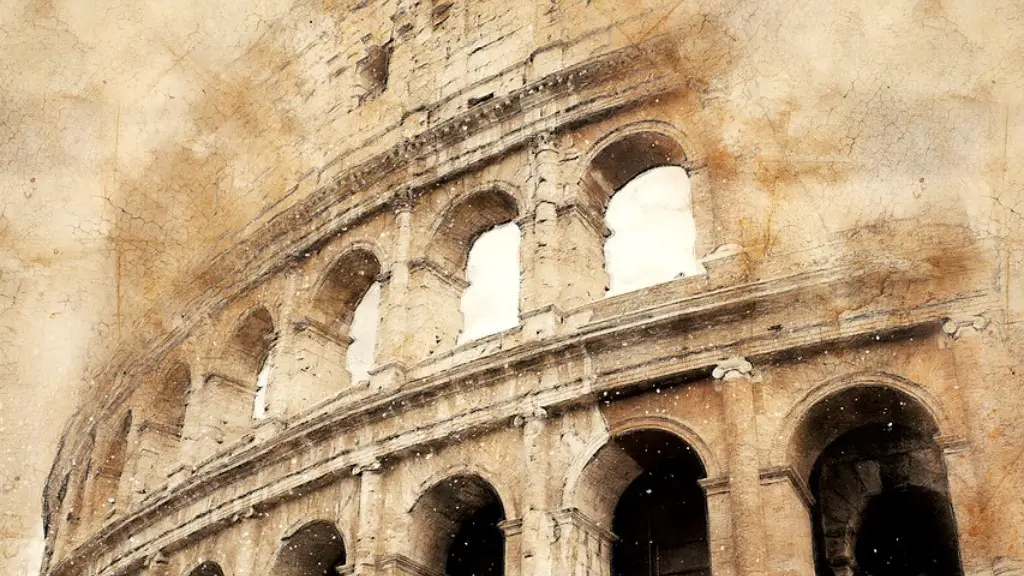Ancient Rome is a fascinating subject of study, especially from a historical perspective. It often serves as a go-to reference point for many of the world’s political, economic and religious systems we use today. But what was the origin and foundations of Rome?
Traditionally, the legendary founders of Rome have been credited as Romulus and Remus, two she-wolf suckled demi-gods. Evidence, however, suggests that this most likely was not the case. The traditional narrative contains many logical and factual issues and dates back to almost 1000 years after the city of Rome was founded. An alternative theory, proposed by scholars and historians such as Livy and Dionysius, is that the first inhabitants of Rome were Latin people who were descendants of primitive farmers, who later intermixed with a large number of Sabine people who lived in the area at the time.
Livy also proposed that Rome was founded by Trojan prince Aeneas, after the fall of Troy. This theory was later enhanced by Virgil’s Aeneid, which provided further details about the journey of Aeneas and his escape from Troy, which he eventually led to establish the city of Rome. It is now widely accepted that these narratives may have had some historical basis and may have helped form the foundations of Roman civilization.
Historians believe that Rome was officially founded in 753BC, based on archaeological evidence related to archaeological sites and Rome’s earliest settlements. It has been argued by some scholars that Rome was officially founded as an Etruscan city and only later adopted Latin as its dominant language, although this is disputed by some scholars.
Regardless of its true origin, it’s impossible to deny the overwhelming presence that Rome has had throughout history and its impact on the world today. Rome has left its mark in the form of religion, language, law and culture, which has helped shape many of the world’s political and economic systems used today. It has also contributed significantly to developments in art, architecture and engineering.
Rome not only rose to prominence through the sheer scope of its conquests, but also its unparalleled efficiency in ruling its vast empire. Its infrastructure, bureaucracy and taxation system allowed Rome to govern with unparalleled efficiency, despite the complex system of government of the time. This legacy of effective governance can be seen throughout many european countries to this day.
The legacy of Rome lives on to this day, and many of its concepts and ideas can be seen in politics, science, law and culture. Its influence is undeniable and can be seen in the form of the Latin language, which is still used in some areas of the world. Ancient Rome serves as an example of what can be achieved when a society is founded on the principles of stability, justice and prosperity.
Constantine I, Religious Tolerance and Rome’s Spread
By the early 300s CE, the Roman Empire had been religiously diverse for centuries. But in 312, a watershed moment arrived when the emperor Constantine I issued his Edict of Tolerance favoring Christianity. This event has been seen as a cornerstone event in the spread of Christianity pervasively throughout the empire and gradually replacing the religions of the past.
Constantine I’s embrace of Christianity granted it institutional, and later religious, legitimacy amongst the inhabitants of the empire, allowing it to develop into the all-encompassing religion of the Roman Empire. As a result of this edict, Christianity spread particularly in the Western Roman Empire, with many of its tenets influencing the cultural and political developments of the region.
Christianity also spread throughout the conquered territories and nations of the empire, firmly establishing itself as the prevalent religion and culture of these places. As a result of this spread, many cultural practices of the conquered nations were gradually divided and assimilated into the Roman customs and beliefs, thereby providing a cultural bridge between the West and the East.
It is clear that the Edict of Tolerance spurred a wave of religious conversion amongst the people of the Roman Empire and its legacy is clearly still seen throughout many parts of the world today.
Rome and the Development of Law
The concept of law is closely linked to the development of Ancient Rome, notably with the discovery of the Twelve Tables and the Codex Aesina in 450 BCE, both of which are cited as some of the earliest known legal codes. Ancient Rome was renowned for its development of law, which influenced many european countries, who applied their own laws. The Twelve Tables served as the mainstay of Roman law and asserted the rights and responsibilities of both citizens and governors by regulating behaviour around family, private property and debt.
As Rome expanded, the Twelve Tables became more exhaustive and diverse, addressing areas such as criminal law, civil liability, and tort. The Codex Aesina also added a preface addressing new kinds of private law such as contract, procedures, status of persons and property.
However, the most influential works in the development of Roman law were the Justinian Code, Constitutions of Justinian, and Novels. These codified many of the laws already in place and served as the mainstay of law in the Empire until its fall. Many European countries continued to use it into the modern era.
To this day, the concept of law and its application is still strongly influenced by Rome. Principles such as the rule of law, presumption of innocence and equality before the law are still fundamental values in many countries around the world.
Rome and its Legacy in the Arts
Ancient Rome’s vast empire left its mark in the form of art, architecture and literature, with some of the world’s most iconic monuments, buildings and sculptures dating back to this period. In architecture, one of the most famous examples is the Colosseum, a huge amphitheatre built as a gift to the Roman people and used mainly for entertainment purposes such as gladiatorial fights and chariot races.
Rome’s influence is also seen in the arts, which bore greatly from its architectural advancements. The influence of the Greek Empire in Rome’s art can be seen in sculptures such as the Nike of Samothrace, which combines the stylistic elements of both nations.
Rome’s legacy in literature is also indelible. The genre of Latin literature, such as the works of Vergil, Catiline and Ovid, draws heavily from classical sources as well as utilising advanced forms of language and structure. Authors such Virgil, Cicero and Ennius are just a few of the great literary minds that contributed to Rome’s literary legacy.
Ancient Rome has had an enormous influence on the development of art, architecture and literature throughout the world. Its monuments, buildings, sculptures and literature are testament to its enduring legacy.
The Roman Number System and Mathematics
The Romans were prolific in the fields of mathematics and astronomy, developing sophisticated systems for timekeeping and navigation, and even making advances in the field of trigonometry. In addition to this, their number system became the leading system used in the continent of Europe, and later the world.
The Roman number system is based on a base-10 system, consisting of Roman numerals from I to M, which each represent a single digit ranging from 1-1000. This number system was much more efficient and easier to use than its predecessor, the Greek number system.
The Romans also developed various maths practices and theories, such as the Rule of Three, which laid the foundations of algebraic calculations. They were even the first to use circles and spheres in calculations. This enabled them to calculate the circumference and area of circles, as well as the distance of objects from the earth.
The Romans also developed a number of other mathematical theories, such as the Binomial theorem, and continued the works of the ancient Greeks in topics such as geometry and number theory. Their influence in the field of mathematics is still felt to this day, with the Roman number system being used as the primary number system in Europe, and later the world.
Rome, Religion and Polytheism
Religion was very much an integral part of the Roman culture and Imperial life, with the population typically worshipping multiple gods and goddesses. This practice dates back to the Etruscan period, which was Rome’s first great period in its history. Worship of various gods and goddesses, termed polytheism, became cemented in Roman culture with the only true established religion being that of the Imperial Cult, which was inextricably linked with the Roman state.
However, other religions were widely tolerated and even encouraged under the Roman Empire. Free worship of the old gods, obsequies and sacrifices, were all seen as vital elements of the Roman state and citizens were free to practise their own, as long as it did not conflict or pose a threat to the Imperial Cult.
Despite their acceptance of polytheism, the Roman Empire would ultimately come to accept the new Christian faith and it, ultimately, became the official religion of the Empire. By the 5th century the Christian empire had spread to all the corners of the Empire, and the ancient polytheistic religions were gradually replaced in the public sphere, but remained in the private lives of many families.
The development of polytheism in Ancient Rome was embedded in the culture and contributed to the durability of the empire. To this day, the influence of Ancient Roman polytheism can still be seen in modern religions and cultures around the world.





